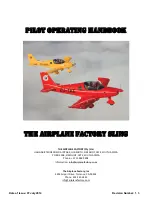
CREW/PASSENGER OXYGEN SYSTEMS (Cont.)
REFILLING OXYGEN SYSTEM (Cont.)
2. If a cylinder has less than 5 psi pressure or has insufficient pressure to produce an audible hissing
sound when valve is cracked, it should be removed and/or purged, and if condition has existed for a
significant length of time, hydrostatically tested.
3. Make sure both charge valve and recharge cart fittings are clean and free of contamination.
– WARNING –
BE CERTAIN THERE IS NO OIL ON FITTINGS OR NEAR
IMMEDIATE VICINITY.
4. Attach service cart hose to recharge port. Fill system at a rate not exceeding 200 psig per minute
proceeding as follows:
a. To obtain correct filling pressure for oxygen system at various ambient temperatures, a table is
included for your convenience. Pressures given are not exact, but sufficiently accurate for practical
purposes of working pressures between 1800 and 2400 psig cylinders. Cylinder should be allowed
to cool to a stabilized temperature after filling before checking against values in Chart 3.
b. When using a recharge unit consisting of one supply cylinder, slowly open valve of supply unit
and allow oxygen to transfer.
c. When using a recharge unit consisting of two or more supply cylinders (cascade storage system),
it is recommended that following procedure be used:
(1) Before opening any valves, check pressure remaining in airplane’s oxygen cylinder. If it is
still partly charged, note pressure indicated on cylinder gauge. Then open and close each
valve on cascade storage system and determine which cylinder has lowest pressure. When
found if this cylinder has a pressure lower than oxygen cylinder in aircraft, do not attempt
using it for filling; use storage cylinder that has a pressure higher than the aircraft’s cylinder
but lower than others.
(2) Open valve on only one storage cylinder with lowest pressure. When pressure indicated on
aircraft’s oxygen gauge and charging gauge has become equal, close valve of storage cylinder;
then go to storage cylinder with next higher pressure and repeat procedure.
(3) If after using last storage cylinder aircraft’s oxygen system is still not fully charged, a full
storage cylinder should be put in place of a cylinder with lowest pressure and used in same
manner.
(4) A good deal of oxygen will remain in large cylinders used in cascade system after filling
only one of cylinders but such remaining oxygen will be at a pressure something less than
1850 psi which is not sufficient pressure to completely refill another aircraft cylinder,
although it will refill several smaller cylinders.
(5) It is not economical even on a three or four cylinder cascade system to begin recharging with
oxygen at less than 300 psi pressure in 300 cubic foot bank of cylinders. So use 300 cubic
foot cylinders down to approximately 300 psi; then return for refilling. In two cylinder
systems use to approximately 100 psi; then return for filling.
d. When pressure gauge on recharge unit or in aircraft reaches 1800 to 1850 psi, close pressure regu-
lator valve on recharge unit. Disconnect filler hose from filler valve; replace protective cap on
filler valve and close access cover. Check cylinder pressure according to Table IIVa after cylinder
temperature stabilizes.
5. After detaching service cart, cap hose and fittings to prevent contamination.
6. Perform a leak check of high pressure lines and clean off solution afterwards. If solution is not proper-
ly cleaned off, unusual corrosion may result.
PIPER AIRCRAFT
PA-32R-301/301T
MAINTENANCE MANUAL
35-10-00
Page 35-16
Reissued: July 1, 1993
3G1
Summary of Contents for PA-32R-301T SARATOGA S
Page 26: ...CHAPTER 4 AIRWORTHINESS LIMITATIONS 1C1 ...
Page 29: ...CHAPTER 5 TIME LIMITS MAINTENANCE CHECKS 1C4 ...
Page 53: ...CHAPTER 6 DIMENSIONS AND AREAS 1D6 ...
Page 64: ...CHAPTER 7 LIFTING AND SHORING 1D21 ...
Page 68: ...CHAPTER 8 LEVELING AND WEIGHING 1E1 ...
Page 72: ...CHAPTER 9 TOWING AND TAXIING 1E5 ...
Page 76: ...CHAPTER 10 PARKING AND MOORING 1E9 ...
Page 80: ...CHAPTER 11 REQUIRED PLACARDS 1E13 ...
Page 92: ...CHAPTER 12 SERVICING 1F1 ...
Page 126: ...CHAPTER 20 STANDARD PRACTICES AIRFRAME 1G17 ...
Page 127: ...THIS PAGE INTENTIONALLY LEFT BLANK ...
Page 139: ...CHAPTER 21 ENVIRONMENTAL SYSTEMS 1H5 ...
Page 188: ...CHAPTER 22 AUTOFLIGHT 1J7 ...
Page 193: ...CHAPTER 23 COMMUNICATIONS 1J12 ...
Page 203: ...CHAPTER 24 ELECTRICAL POWER 1J22 ...
Page 263: ...CHAPTER 25 EQUIPMENT FURNISHINGS 2A13 ...
Page 269: ...CHAPTER 27 FLIGHT CONTROLS 2A20 ...
Page 332: ...CHAPTER 28 FUEL 2D11 ...
Page 363: ...CHAPTER 29 HYDRAULIC POWER 2E18 ...
Page 404: ...CHAPTER 30 ICE AND RAIN PROTECTION 2G16 ...
Page 470: ...CHAPTER 32 LANDING GEAR 3A13 ...
Page 550: ...CHAPTER 33 LIGHTS 3D24 ...
Page 562: ...CHAPTER 34 NAVIGATION AND PITOT STATIC 3E12 ...
Page 582: ...CHAPTER 35 OXYGEN 3F8 ...
Page 604: ...CHAPTER 37 VACUUM 3G6 ...
Page 616: ...CHAPTER 39 3G18 ELECTRIC ELECTRONIC PANELS MULTIPURPOSE PARTS ...
Page 620: ...CHAPTER 51 STRUCTURES 3G22 ...
Page 636: ...CHAPTER 52 DOORS 3H14 ...
Page 650: ...CHAPTER 55 STABILIZERS 3I4 ...
Page 662: ...CHAPTER 56 WINDOWS 3I16 ...
Page 670: ...CHAPTER 57 WINGS 3I24 ...
Page 688: ...CHAPTER 61 PROPELLER 3J18 ...
Page 704: ...CHAPTER 70 STANDARD PRACTICES ENGINES 3K10 ...
Page 708: ...CHAPTER 71 POWER PLANT 3K14 ...
Page 737: ...CHAPTER 73 ENGINE FUEL SYSTEM 4A13 ...
Page 749: ...CHAPTER 74 IGNITION 4B1 ...
Page 783: ...CHAPTER 77 ENGINE INDICATING 4C11 ...
Page 793: ...CHAPTER 78 EXHAUST 4C21 ...
Page 801: ...CHAPTER 79 OIL 4D5 ...
Page 805: ...CHAPTER 80 STARTING 4D9 ...
Page 819: ...CHAPTER 81 TURBINES 4D23 ...
Page 833: ...CHAPTER 91 CHARTS WIRING DIAGRAMS 4E13 ...
















































